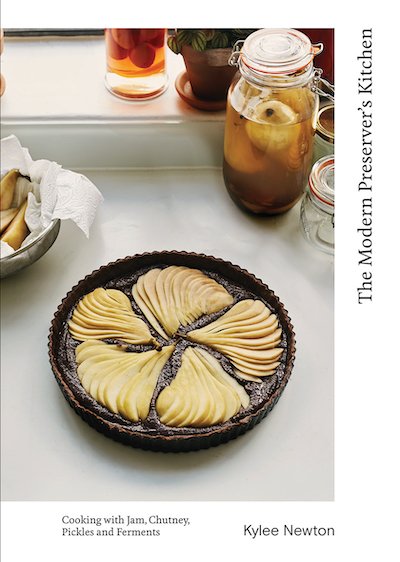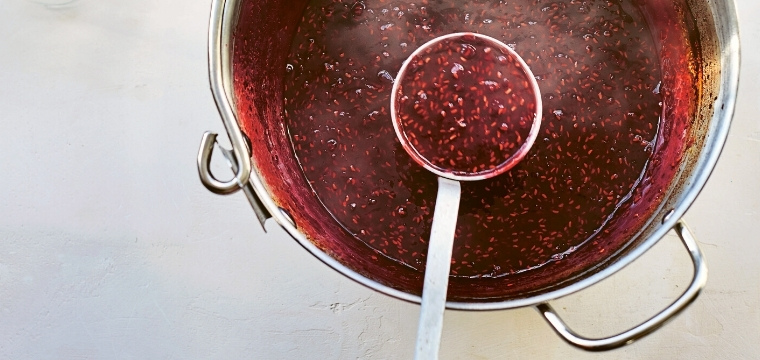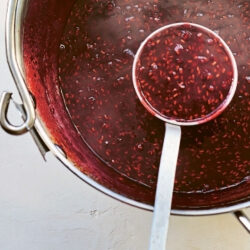Kylee Newton’s Raspberry & Elderflower Jam Recipe
Equipment
4–5 x 250ml (8½fl oz) jars
Raspberry & Elderflower Jam recipe from “The Modern Preserver’s Kitchen: Cooking with Jam, Chutney, Pickles and Ferments” by Kylee Newton.

Kylee Newton grew up in New Zealand and lives in London. She began making preserves to give as homemade Christmas presents, which lead to the creation of her London-based preserving company Newton & Pott, making quality jams, pickles and chutneys. Kylee is an expert in her field and now focusses her attention on hosting preserving workshops, food writing, food consultation and recipe development.
This is an edited extract from The Modern Preserver’s Kitchen: Cooking with Jam, Chutney, Pickles and Ferments by Kylee Newton, published by Quadrille, RRP $45 AUD, is available in-stores nationally.
Photography: Laura Edwards
Raspberry & Elderflower Jam
Makes 4–5 x 250ml (8½fl oz) jars
Ingredients
- 900g (2lb) raspberries, fresh or frozen
- 40ml (2½ Tbsp) water
- 30ml (2 Tbsp) freshly squeezed lemon juice
- 500g (2½ cups) white granulated sugar
- 80ml (scant ⅓ cup) elderflower cordial or syrup
Instructions
-
- Place several small saucers in the freezer at least 1 hour before you start. Always begin by sterilizing your jars and lids and use them straight from the oven.
-
- Heat and soften the berries, until they becomes pulp. For whole chunky bits in your jam, keep some berries aside for later in the process. Add the water measurement (if using) and the lemon juice to help it soften. If using frozen berries, defrost it first and don’t add the water, as it retains a lot in the freezing process. Only stir now and again at this stage, so it doesn’t stick to the bottom of the pan. Different fruits are stickier, so be vigilant and never walk away from your jam.
-
- When it is pulpy and bubbling, add the sugar, stirring until it has completely dissolved. Add any of the extra whole berries here, so they don’t break down as much. Turn up the heat to the highest setting, and only stir intermittently, not allowing too much cold air into the mix. There’s a fine line between stirring to ensure it’s not catching and burning and stirring too much and lowering its temperature. Ideally, you want the jam to get to a temperature of 104°C (220°F).
-
- I find thermometers unreliable, so to judge when my jam is ready for set/wrinkle testing and jarring, I boil it on the highest heat until the rolling bubbles thicken, becoming slower and ploppier. This is the heat struggling to break through to the surface as the density of the jam becomes thicker and “jams up”. Timings always differ, depending on the fruit pectin levels, the pan you are using, and the heat source – even the temperature of the room can affect your timings – so use your eyes and instinct to make a judgement.
-
- When ready to test, remove the pan from the heat, take one of the saucers from the freezer, drop ¼ teaspoon of jam onto the frozen saucer and place in the fridge for 1 minute. This mimics the cooling process. Remove the saucer and gently push the jam with your finger. There should be a hard or soft wrinkle on the surface for a hard or soft set. Not all fruits will ever make it to a hard set, creating a prominent wrinkle. So with a soft set, scoop it up with the forefinger and allow it to drip off – you’ll want a slow drip. If not at the desired set, return to the heat and test again until it is.
-
- If ready, skim off any foam and stir through any elderflower flavourings. Ladle the hot jam into hot sterilized jars through a wide-mouthed funnel or pour from a heat-proof jug, filling the jars to 2–3mm (⅛in) from the top. Clean the rim with a damp cloth and seal immediately with a hot sterilized lid. This needs to be a speedy process so you don’t lose too much heat from the jam or the jar. Seal everything immediately so that bacteria can’t survive in high temperatures. Once cooled, date and label.

Notes
-
- Jams can be stored in a cool, dark place for up to 6–12 months.
-
- Once opened, store in the fridge and eat within 4–6 weeks.
-
- Raspberries are medium in pectin and acidity making for a firmer set. Don’t overcook your jam if you like a softer texture.
-
- Try using rosehip syrup, rose extract, orange blossom cordial, ginger cordial, Earl Grey tea, chamomile tea, lemon verbena tea, yuzu cordial, lemongrass syrup, hazelnut syrup, vanilla extract, rose extract or almond extract. If using, stir through at the end of the process, after skimming off the foam and before jarring.
-
- Try different fruit jam combinations, such as gooseberry and chamomile tea, leaving in some of the flowers; raspberry and rose; blackberry and yuzu; plum and lemongrass.
Find the Victoria Sponge recipe here



